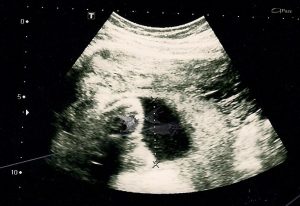Pregnancy is a very unique moment in any woman’s life. It’s when the most significant changes occur in her body1, after all, an entire life is being created inside you. For this reason, it’s not uncommon for a multitude of doubts to arise throughout the weeks while the baby is growing in your womb. Issues such as excess fluid during pregnancy are an example of a rare phenomenon, and because of this, they generate many questions. We decided to gather the main questions about this condition to explain why it happens and how to deal with this type of situation. But first, it’s essential to understand how a woman’s body works during pregnancy.
What Is the Function of Amniotic Fluid?
Amniotic fluid is nothing more than the “water” that surrounds the baby throughout pregnancy2. This is the fluid that leaks out when the water breaks, signaling the start of labor. It is produced by the placenta and allows the baby to move more freely inside the uterus, which also stimulates the start of movements. Amniotic fluid is absorbed by the baby both through the skin, especially in early pregnancy, and by swallowing the fluid.
Although many don’t know, this fluid has many functions and is extremely important for pregnancy. Some of its main functions are:
- Maintaining the baby’s temperature
- Protection against impacts together with the placenta
- Protection against potential bacteria
- Stimulates the baby’s digestive and respiratory development
How to Tell If There Is Excess Fluid?
To know if there is excess fluid during pregnancy, you need to know what is considered a normal amount. It is estimated that this amount increases as pregnancy progresses, reaching between 800 and 1000ml at its peak. However, before labor, this amount starts to decrease, and the amount that comes out when the water breaks is already less than that.
What will determine excess or lack of fluid during pregnancy is the ultrasound exam. Of course, this is accompanied by some signs, such as very tight skin and a very sudden growth of the uterus. The doctor will also assess the size of the uterus compared to the stage of pregnancy and may suspect excess or lack of amniotic fluid.
Causes of Excess Fluid During Pregnancy
Excess amniotic fluid, also called polyhydramnios3, can have various causes. Among them are:
- Incompatibility of the RH factor between mother and baby
- Diseases such as syphilis and rubella, which end up causing infections
- Multiple pregnancy, especially when there are identical twins
- Chromosomal abnormalities in the baby
- Maternal diabetes
The causes of excess fluid in pregnancy are not always linked to diseases or something negative. In the case of multiple pregnancies, for example, the fact that the woman’s body needs to produce more fluid often results in a slight excess. However, it is always important to remember that risks do exist.
Risks of Excess Fluid During Pregnancy
The main risk of polyhydramnios is preterm labor, since the excess fluid causes the uterine wall to stretch more, consequently inducing labor. The big issue is that the baby may be born without being fully developed, which can lead to minor heart or respiratory problems such as bronchitis and asthma, for example. There is also the possibility that the umbilical cord is put under a lot of pressure due to the excess fluid, making oxygen transport to the fetus more difficult and causing even more serious problems.
Is There a Treatment for This?
When excess fluid is identified, the doctor will run some tests to determine whether the mother needs to be treated to resolve the issue. The initial treatment will address the underlying
disease affecting the mother. Some types of medication may reduce the amount of amniotic fluid in the uterus. In more serious cases, drainage of the fluid can be performed, but this is a very delicate procedure and can have serious consequences if not done perfectly, which is why it is only done in extreme cases where the baby or mother are at serious risk.
Can This Affect Labor?
The main impact of excess fluid during pregnancy is on when labor will happen, since this condition often induces preterm labor. Still, there are other complications, such as the danger of the umbilical cord breaking due to the strong pressure of the excess fluid. Placental abruption and postpartum hemorrhage are other complications resulting from polyhydramnios that can make it difficult for the uterus to return to its normal size. For these reasons, when there are cases of excess fluid, doctors usually recommend a cesarean delivery, as it helps avoid these types of complications.
Problems like excess fluid during pregnancy are quite rare, but that doesn’t mean they’re impossible, or that you shouldn’t know more about the subject. In fact, the more you understand about how a woman’s body functions during pregnancy, the more easily your questions will be answered and the less worried you’ll be about possible problems. Pregnancy is a time full of wonderful moments, but it’s also necessary to overcome the difficult times, because in the end it will always be worth it.
See Also: Amniotic Fluid – Can Having Too Little or Too Much Cause Problems?
Photo: Dahab AA, Aburass R, Shawkat W, Babgi R












